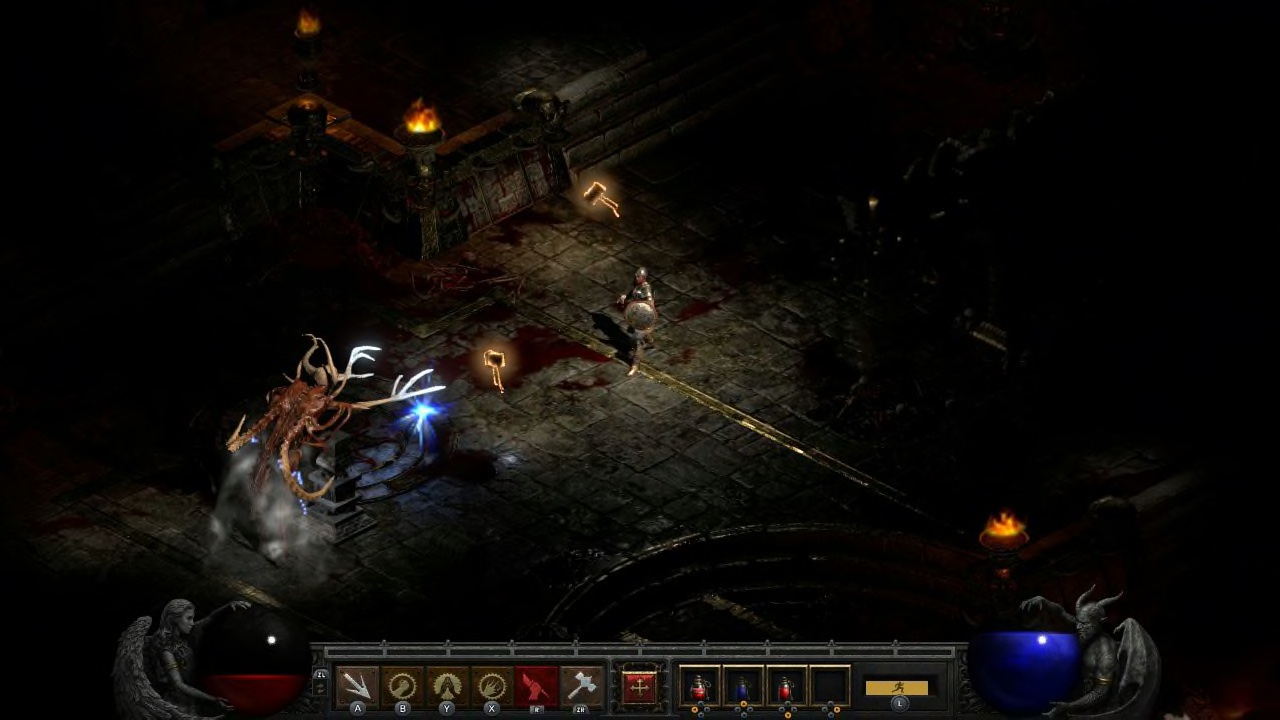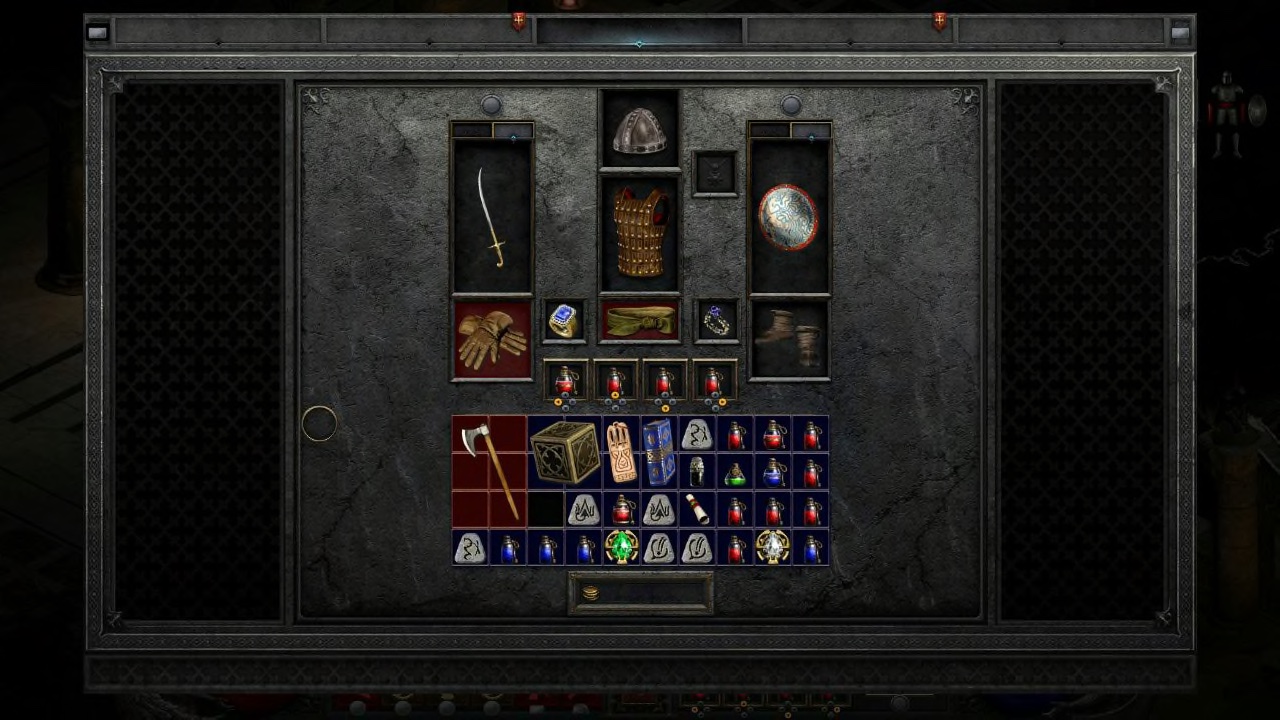Get thee behind me, multiplayer.
Despite suffering my way through the ’90s, I never gave a thought to Christina vs. Britney. I had no dog in the fight between NSYNC and Backstreet Boys. What I did care about was Baldur’s Gate vs. Diablo, where I was firmly on the side of team BG.
I mention this not to trash ’90s pop culture…again…but to explain why I’ve never played a Diablo game until now. The series interested me, but Baldur’s Gate appealed to me more. Now that I’ve played Diablo II on the Switch, I…well, I won’t say I was on the wrong side, but I can freely admit that bypassing Diablo was a mistake.
Being a port of PC game from 2000, I was instantly pleased by how good the Switch version looked. The graphics have been modernized, of course, but they still retain that dark, detailed look of the isometric RPGs of the time. The lighting effects are fantastic, adding tremendous atmosphere to the numerous dungeons you’ll be exploring. The enemies look great, too; like from a creepy ’90s horror movie.
Even the cutscenes have been remade. This is a good thing, because dated visuals can really drag down the experience.
The game starts by forcing you to create (or log into) a Battle.net account. There’s nothing suspect about this, but it did throw me for a loop on the Switch. You then decide if you’re going to play on or offline. Again, thrown loop. You’ll need to go online through battle.net if you want to play with others (there is no local multiplayer), and there have been numerous reports of server outages completely killing this experience. Offline is definitely the correct choice if you’re willing to go it alone and keep it that way. Unfortunately, you can’t move your game progress between offline and onload modes.
Once you’re through all of that nonsense, you can pick your class from the seven available: Amazon, Assassin, Barbarian, Druid, Necromancer, Paladin, and Sorceress. You’ve likely been through enough of these games to know how they work (a tank, a ranged fighter, better balance, healing, etc.), and the wildly different styles add longevity to the game. When you’ve completed it with one character, playing through as another can greatly impact the gameplay and your strategies.
Of course, so do the randomly generated levels. One of the reasons I opted for Baldur’s Gate back in the day is because it told a better story with a clearer route through it. I liked that. Diablo II is more about its core gameplay loop. You set out from camp with the tools/skills available to you, and push as far as you can to acquire skills and loot. Your inventory is severely limited, however, so you’ll either have to leave items behind or return to base to drop them in storage or sell them.
Many items have to be identified to determine their worth (and it can cost money to do that), so there will be plenty of trips back and forth. The game does give you the occasional portal and travel spells to ease this process, but there will still be times when you’re more likely to dump things you may not need so you can push forward.
Moving controls from keyboard/mouse to a gamepad is never easy, but Blizzard has done a pretty good job. Quick items and spells can be mapped to various Joy-Con buttons, and the game’s interface does a great job of reminding you how to get to them. The game does little to explain what some of these items/skills do, but once you learn, it’s easy to get to what you want.
Some control issues could’ve been better addressed, however. For example, the attack button is the same as the pick up button. As such, you’ll often grab things you don’t want when you’re trying to kill an enemy. Not only does this put you in unnecessary danger, it also means you’ll have to spend time dumping things you never wanted to begin with. On the other hand, it’s pleasantly surprising to open your inventory and have something wonderful in there that you don’t recall grabbing during the heat of battle.
That’s important, because the whole point of Diablo II is to get better. Level up to gain better skills. Locate and utilize better armor, weapons, and spells. The difficulty ramps up quickly, so you need to keep grinding through the hordes of enemies in order to prepare yourself for the next run.
The next run is hopefully enough for you, because the story is perfunctory at best. If you worry about why you have to face off against a certain monster, you’ll be disappointed. If you just want to face that monster, go for it. There’s plenty to keep you engaged along the way, and that’s why Diablo II works so well on the Switch. The focus on action keeps things moving at a brisk pace, and the myriad customization controls keep the player engaged with the proceedings.
So, who should get it? Fans of the original may enjoy the trip down memory lane. If you’ve already played Diablo III: Eternal Collection on the Switch and would like to keep the fun going, Diablo II: Resurrected will serve that purpose. Or, if you’re like me, it’s a decent point of entry through the gates of hell…provided you’re OK making the trip on your own.
Review: Diablo II: Resurrected (Nintendo Switch)
Good
Diablo II: Resurrected gets enough polish and features to appeal to fans of the original release and to series newcomers. The exploration/combat loop is still fully engaging, with only a few remnants of its age interfering with gameplay on the Switch.







October 19, 2021
[…] Source link : Purenintendo […]